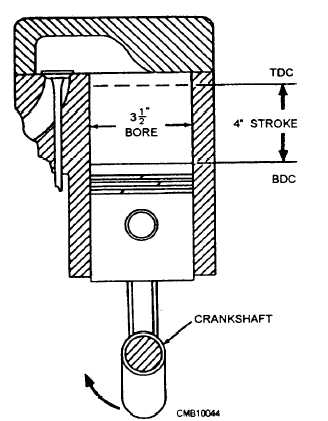A portion of this waste heat may be channeled to the passenger compartment to heat it.
The lubricating oil in the engine removes a portion of the waste heat.
In addition to energy lost through waste heat, there are the following inherent losses in the piston engine.
Much energy is consumed when the piston must compress the mixture on the compression stroke.
Energy from the fuel is consumed to pull the intake mixture into the cylinder.
Energy from the fuel is consumed to push the exhaust gases out of the cylinder.
The combination of all these factors in a piston engine that uses and wastes energy leaves the average engine approximately 20 to 25 percent thermally efficient.
LINEAR MEASUREMENTS
The size of an engine cylinder is indicated in terms of bore and stroke (fig. 2-24). BORE is the inside diameter of the cylinder. STROKE is the distance between top dead center (TDC) and bottom dead center (BDC). The bore is always mentioned first. For example, a 3 1/2 by 4 cylinder means that the cylinder bore, or diameter, is 3 1/2 inches and the length of the stroke is 4 inches. These measurements are used to figure displacement.
PISTON DISPLACEMENT is the volume of space that the pistondisplaces, as it moves from one end of the stroke to the other. Thus the piston displacement in a 3 1/2-inch by 4-inch cylinder would be the area of a 3 1/2-inch circle multiplied by 4 (the length of the stroke.) The area of a circle is π where R is the radius (one half of the diameter) of the circle. With S being the length of the stroke, the formula for volume (V) is the following:
V = π x S
If the formula is applied to figure 2-22, the piston displacement is computed as follows:
R = 1/2 the diameter = 1/2 x 3.5 = 1.75 in.
π = 3.14
V = π (1 .75)2 x 4
V = 3.14 x 3.06 x 4
V = 38.43 cu in.

Figure 2-24. - Bore and stroke of an engine cylinder.
The total displacement of an engine is found by multiplying the volume of one cylinder by the total number of cylinders.
38.43 cu in. x 8 cylinders = 307.44 cu in.
The displacement of the engine is expressed as 307 cubic inches in the English system. To express the displacement of the engine in the metric system, convert cubic inches to cubic centimeters. This is done by multiplying cubic inches by 16.39. It must be noted that 16.39 is constant.
307.44 cu in. x 16.39 = 5,038.9416 cc
To convert cubic centimeters into liters, divide the cubic centimeters by 1,000. This is because 1 liter = 1,000 cc.
5,038.9416 = 5.0389416
_____________
1,000
The displacement of the engine is expressed as 5.0 liters in the metric system.Continue Reading
